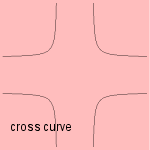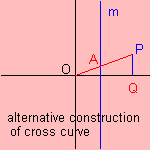
|
 |
 |
 |
 |
 |
 |
cross curve |
quartic |

 The cross curve can be constructed in
the following way.
The cross curve can be constructed in
the following way.
Given a ellipse H,
construct for every tangent the intersection with both x-axis and y-axis, giving
points A and B respectively. Then draw a line l through A parallel to
the y-axis, and a line m through B parallel to the x-axis. Then the intersection
of line l and line m lies on the cross curve.

 This definition is a variation of the definition of the bullet
nose. As is also to been seen at the curve's formula:
This definition is a variation of the definition of the bullet
nose. As is also to been seen at the curve's formula: ![]()
r = xy is a mixed polar-Cartesian equation for the curve.
The curve can be constructed in an alternative way as follows.
Given a vertical line m. The cross curve is formed by the points P for which the
distance to the x-axis is equal to the distance from the origin to the crossing
of OP and m (PQ = OA in picture).
Other names for the curve are: (equilateral) cruciform (curve), stauroid and the policeman on point-duty curve.
The curve is a Lamé curve, and also an epi spiral.
The curve has been studied by Terquem (1847) and Schoute (1883).